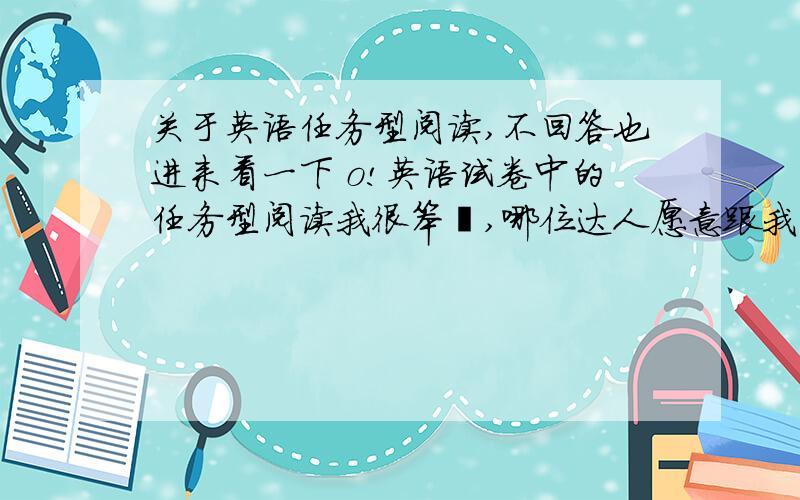关于英语任务型阅读,不回答也进来看一下 o!英语试卷中的任务型阅读我很笨哒,哪位达人愿意跟我分享一下经验呢?
来源:学生作业帮助网 编辑:作业帮 时间:2024/05/07 00:49:56

关于英语任务型阅读,不回答也进来看一下 o!英语试卷中的任务型阅读我很笨哒,哪位达人愿意跟我分享一下经验呢?
关于英语任务型阅读,不回答也进来看一下 o!
英语试卷中的任务型阅读我很笨哒,哪位达人愿意跟我分享一下经验呢?
关于英语任务型阅读,不回答也进来看一下 o!英语试卷中的任务型阅读我很笨哒,哪位达人愿意跟我分享一下经验呢?
任务型阅读理解题型的特征和一般解题方法
任务型阅读理解题所选文章题材主要以广告、海报、通告等应用文体为主.任务型阅读,一般不难于常规性阅读.该题提供六段阅读材料,布置五个“话题”,要求考生将这五个“话题”与所给的六段阅读材料中的五段一一“对应”(有一段是多余选项).该“对应”可能是“主旨对应”,也可能是“情节对应”,还可以是“细节对应”等.考生答好该题的要诀有二:一是理解段落主旨和细节,同时既注重说话人字面意思,也领悟其可能隐含的“话中有话”;二是切实做到“阅读仔细,观察敏锐,精确配对”.
该类阅读理解题的解题的关键在于正确把握住当事人的要求与符合其要求的条件之间的一一对应关系.同学们解题时一般适宜采用各个击破的方式,先确定和划出任务型阅读题目(问题)中的关键信息(一般有2、3个信息点),再用快速寻读的方法从A到F6条语段中寻找和确定一条含有解答该问题的相应信息(一般也2、3处).运用快速逐一排除法能为同学们节省一定阅读和答题时间.当然排除干扰信息和一项多余信息条还需要一定时间操练.任务型阅读理解“一一对应”解题方法通常包括具体步骤如下:
第一步:认真阅读试题背景,了解阅读材料的背景、话题或主题,确保解题时不脱离阅读的主题和正确思维的主线索.
第二步:仔细阅读题目,找出不同人物的不同要求,并在关键词下划线,以便有利于为第三步的的顺利解题创造良好的和必要的条件.
第三:对照题目的要求,从A、B、C、D、E和F六个备选项中选出符合以上要求的对应条件.有时,我们只要顺着关键词的线索就能轻松找到正确的答案.例如,有一篇有关体育题材的任务型阅读理解的题目要求中涉及到姚明的NBA生涯,考生只要在备选项中找到”姚明”这个关键词,不用阅读整个题目和备选项就能轻松找到正确的答案.但是,在大多数情况下,还要从提出的若干备选项选择符合条件中的内容.同学们需要根据具体的情况灵活地选择解踢方式,跳读、扫读还是细读.在此,特别提醒各位同学:选项中肯定有一项是多余选项.
第四步:快速对照“要求”和“条件”这一主要线索通读一遍,做到万无一失,提高答题的准确率,增强应试的信心.
我落伍了
不知道任务型阅读是啥
完了
说真的我不会····
但是经验是积累来的···我想说的话也是说不清楚的。。。
你还去是网站查查资料吧··
先把阅读大致读一遍,然后再看问题,看问题中的单词和文章中的那个一样,再看所在句子的大意,和答案中的哪个差不多,就是那个了!(本人经验,对别人有可能没用。)
其实英语阅读并不是很难呀!不管是任务性的还是选TorF的或者是回答问题的,都有个方法。(我自己是这样做的)做题前,先把问题看看,在阅读,在文章中寻找与问题相同的短语或者相近的句子。如果有许多单词不会,凭语感做也是个不错的选择。(前提是你平时有一定的阅读量)...
全部展开
其实英语阅读并不是很难呀!不管是任务性的还是选TorF的或者是回答问题的,都有个方法。(我自己是这样做的)做题前,先把问题看看,在阅读,在文章中寻找与问题相同的短语或者相近的句子。如果有许多单词不会,凭语感做也是个不错的选择。(前提是你平时有一定的阅读量)
收起
你说的任务型阅读是不是就是阅读理解啊??如果是我的话~我一般都是在文章中找答案的,你可以先看 一下文章,了解一下文章的内容,然后开始看题目,看了题目后到文章中去找答案,或者去找相关的语句并把她划出来,然后在看一遍文章~(当然,如果在考试的时候,可能时间不够,就不定要看了)但是在平常做的时候就应该这样,而且应该要提高自己看文章和作题目的速度~据我个人经验啊,我一般都会在考试时,做完阅读,就直接做后面...
全部展开
你说的任务型阅读是不是就是阅读理解啊??如果是我的话~我一般都是在文章中找答案的,你可以先看 一下文章,了解一下文章的内容,然后开始看题目,看了题目后到文章中去找答案,或者去找相关的语句并把她划出来,然后在看一遍文章~(当然,如果在考试的时候,可能时间不够,就不定要看了)但是在平常做的时候就应该这样,而且应该要提高自己看文章和作题目的速度~据我个人经验啊,我一般都会在考试时,做完阅读,就直接做后面的第二卷,不会的题目先空着,呆会回过来再看文章的时候就比较好理解了啊,不过前提是你必须头脑清楚啊~~~(纯属个人经验~~可能也只是针对我个人而言啊~)
收起
就是多读,其它好像没有什么更好的办法。
语感很重要 多看看老外写的东西
阅读题要多做,做时要多读几遍,先读题,在看题目,这样对做这种题就有很大的帮助,平时要多做这一类的题目,考试时就很顺手!
首先,你要明白老师出题是什么目的,你才能回答老师要的答案,所以,如果你看得动,就先看一看下面的文章:
Task-based reading teachingReading is one of the four language skills and of two receptive skills. For me, it’s the most important way to learn. ...
全部展开
首先,你要明白老师出题是什么目的,你才能回答老师要的答案,所以,如果你看得动,就先看一看下面的文章:
Task-based reading teachingReading is one of the four language skills and of two receptive skills. For me, it’s the most important way to learn. Through ELTM course, we have learned TBLT, but how can we use TBLT to teach reading? The most important thing is to get students to read. In class, we should select interesting materials and after class, we should help them to choose materials of proper difficulty level according to their interests. According to Willis, task-based learning is typically based on three phases: pre-task, task-cycle and language focus. Built on the suggestion to the class activities, the pre-reading task can be completed in the process of pre-task and the while-reading, post-reading tasks can be fulfilled in the “task cycles”. Each reading activity should be performed in the form of tasks. Obviously, task design is very essential to the accomplishment of TBRT, the task is mainly made up of the following three parts: different teaching goals in different stages; the teaching materials; different designed activities based on the teaching materials. Different designed activities based on the teaching materials. Design the task When we use task-based reading teaching, we should well design the reading task. First, task should be accessible to the learners. Inaccessible task do help improve learner’s reading skills but cause frustration. That is to say, tasks given should be of a more overall---within the competence of the students. Second, tasks should be designed to encourage selective and intelligent reading for the main meaning rather than test the learners’ understanding of trivial details only. Third, tasks should help develop learners’ reading skills rather than merely test their reading comprehension. If teachers always ask learners to read passages then answer multiple choice questions, they are actually testing them not developing their reading skills.Four, tasks should help the learners not merely to cope with one particular text in front of them but with their reading strategies and reading ability in general. We should encourage them to use reading strategies that will enable them to tackle any further texts. Two patterns of TBRTReading teaching should not only constrain in the classroom and the textbook. We should consider learners’ cognitive ability, interest and motivation. Therefore, it is necessary to construct patterns for task-based reading teaching in the class and to design a great variety of tasks so as to train their reading ability and accelerate their all-way development. There are two patterns of TBRT, namely, task-based intensive reading and task-based intensive reading Task-based intensive reading In the reading teaching, teachers should make the definite goal and supporting goal. Teachers should follow the principle of cognitive and provide the learners with tasks step by step. Learners can obtain and process the information, experience language and train their reading strategies. In task-based intensive reading class, we should design tasks centered on reading materials and emphasized on improving learners’ reading comprehension and training their reading strategies and reading skills so as to lay a good foundation for the in-depth development of reading ability.A pattern for the class of task-based intensive reading teaching ⑴Pre-reading tasks for interest: lead out topics and arouse interestStep one warm-up task Step two lead-in tasks⑵While-reading tasks for comprehension and for reading skills Step one designing the reading tasks Step two reading and then working in groupsStep 3 reportingStep4 language focusStep5 reading again and discussion ⑶Post reading tasks for production: activate the teaching materials ⑷Language-application task after class⑸Reading assessment for improvement: form responses to teaching and making out evaluation Task-based extensive reading teachingThe textbook has a lot of interesting content, but sufficient input is essential to acquire a language. The language input to learners is limited, so we should help students to choose other materials after class.Teachers should not only have the responsibility for providing abundant language input but also teach learners how to look for information. Before class, many exercises can be assigned to learners. A pattern for the class of task-based extensive reading teaching ⑴Before class: reading to a large extentLearners are required to look for and gather information according to the task assigned before class⑵In class: depth-readingThe teacher provides reading material. Using the “up-bottom” reading model, learners, with the help of their own background knowledge and experience, are expected to deal with the information conveyed by the writer.⑶After class: presentation of reflection.Learners can fully absorb information and solve problems. Meanwhile their communicative competence is shaped. ⑷Outside classroom:In this stage, learners can enlarge vocabulary and enrich their knowledge, widen their eyesight. Learners learn to know about the society and life.⑸Reading assessment for improvement: form responses to teaching and making out evaluation
然后,看看这个:
http://scholar.ilib.cn/abstract.aspx?A=bjjyxyxb200302017
总之,带着目的阅读,就是最好的办法.
收起
任务型应该就是阅读理解吧,呵呵,都出现这新名词了呀.
我觉得就是先通篇看一下,了解一下大致意思,然后看题目,在文章中定位,大概哪里会有,有空上网问还不如去多做几篇来的快哦...